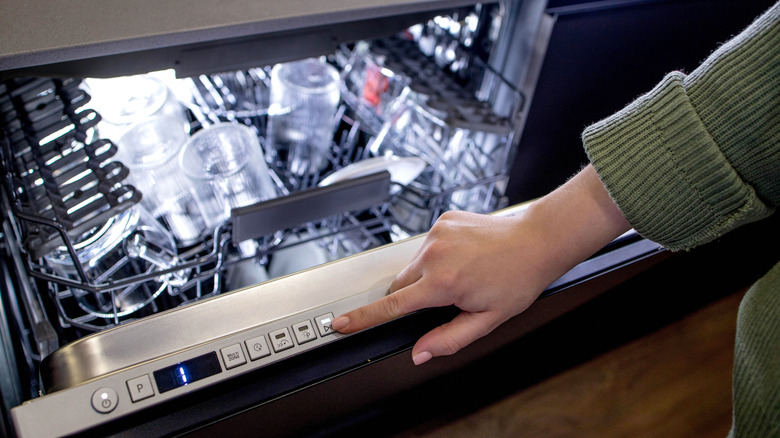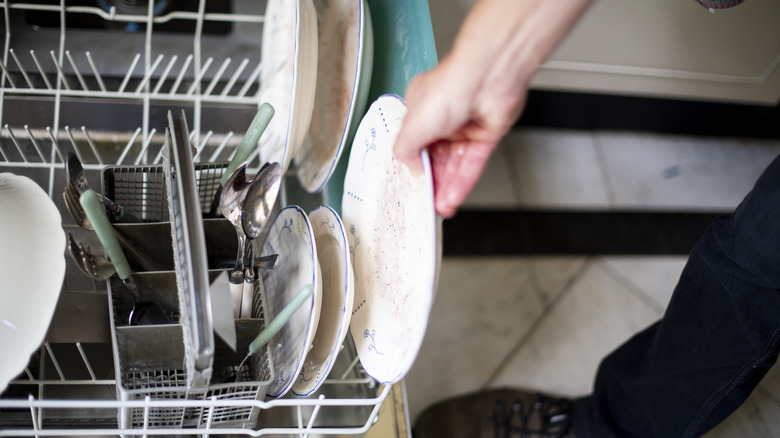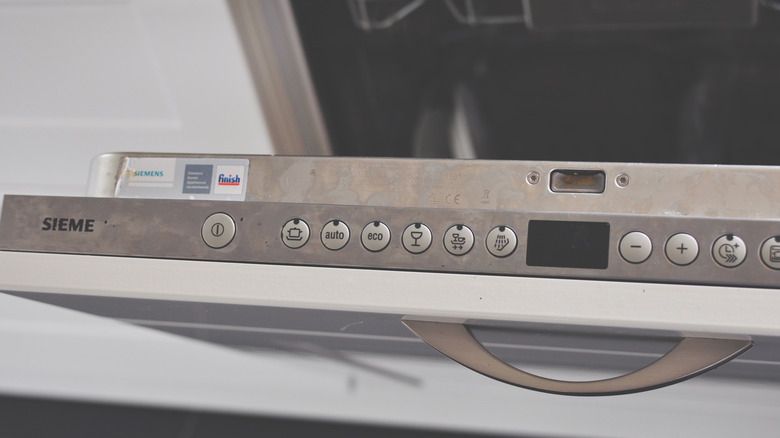The Best Dishwashing Cycle For The Cleanest Dishes Without The Guesswork
Do you ever pause in front of your dishwasher, wondering what the different settings mean? Modern dishwashers have tried to take the guesswork out of cleaning your dirty dishes and crusted-over casserole pans with the Auto or Sensor Wash cycles. This "smart" setting uses sensors and soil-detection technology to assess how dirty your dishes actually are, then automatically adjusts the water temperature, pressure, and cycle length for the best results. Unlike preset cycles that run the same program no matter what you put in the dishwasher, the Auto cycle figures out exactly what's needed and adjusts accordingly. Sensors will measure food particles in the initial rinse, then determine if the wash time needs to be extended or if an extra rinse is required, without any input needed on your part. It's a hands-off approach to getting customized wash cycles.
It is important for you to know what all of your dishwasher settings actually mean to get the best clean and protect your kitchenware. But the Auto cycle is the best option for everyday use because it will adapt the wash settings for you. A lightly loaded dishwasher might trigger a shorter, cooler wash, while a heavy load with multiple casserole dishes and plates triggers something more intense. The adjustments not only improve the cleaning power of your dishwasher, but they also help you conserve energy and water compared to just running every load on the Heavy cycle. Most manufacturers have Auto as the default setting, so you might already be using it.
The benefits of letting your dishwasher decide the wash settings
Auto cycles use multiple smart technologies to get better results out of your dishwasher with less resource consumption. Some sensors measure the water's cloudiness to gauge how much mess is still on your dishes, while others measure the temperature inside to make sure the dirty dishes are getting cleaned as they should. Advanced models even measure the load size through water flow sensors, adjusting spray arm patterns as needed to wash the contents of the machine adequately. All of these systems work together to ensure the perfect wash every time you use the setting on your dishwasher.
There are plenty of environmental benefits to an Auto wash as well. By matching each dish load with exactly what it needs, Auto settings reduce water and energy usage every cycle compared to a standard wash. They also prevent unnecessary energy from being used for heating and long cycle times. Lighter loads will still get clean with less water, lower heat, and shorter cycles, allowing increased efficiency.
Meanwhile, cleaning performance improves because the system increases wash time when needed, allowing more time for the machine to work out tough stains while avoiding excess wear on your dishes during light loads. If you do start to notice your Auto cycle running longer loads despite the dishes inside, you may need to take some time and properly clean your dishwasher to make sure it's running at its best.
When to override the Auto setting for special circumstances
While the Auto cycle can handle your normal, everyday loads, sometimes you need to know how to use your dishwasher better, and certain situations need some manual decisions. If you're cleaning heavy cookware with plenty of baked-on food residue, you may need to turn to a more intense setting — most dishwashers have a Pots & Pans or Heavy cycle that will do the trick. These special settings increase the water temperature for longer and have more aggressive spray patterns to work out that leftover mess. On the flipside, more sensitive items like wine glasses or crystal dishes will benefit from a lower setting, usually called Delicate or Light. This reduces the heat and uses a lighter spray to protect your expensive and fragile items. These settings are ideal in certain situations where the Auto cycle might not recognize what's in your dishwasher.
Many models also have a Sanitation cycle, which can be used specifically to sanitize dishes with temperatures over 150 degrees Fahrenheit. This cycle works great for things that need that boost of cleanliness, like cutting boards, kitchen tools, or baby bottles. While some Auto cycles may eventually reach these higher temperatures for heavy loads, they can't guarantee the extra heat exposure time required for true sanitation. In the end, the Auto cycle on your dishwasher is there for your everyday needs and adapts to almost exactly what is inside your wash at any time, but having the other setting options is a nice addition when something specific arises.


